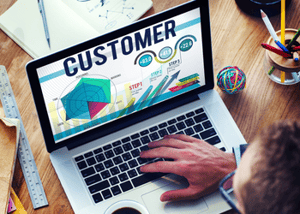Can you imagine a life without smartphones, without apps to help you navigate, play your favorite music or, say, buy insurance for your rental car right before you board a plane? It’s strange how we got used to this new way of living so quickly, because we grew up without any of the digital technologies that define it. Eager to follow suit, organizations are enthusiastically working to make their digital aspirations a reality.
Digital strategies are drawn up, or at least talked about. But a few digital initiatives here and there are not enough to call yourself a digital organization. We believe digital strategies need to be more ambitious and thought-through than they currently are, many of them misfiring or not even getting implemented at all. It makes one wonder: why is that so often the case? And does this scenario apply to all sectors? Read on to get some pointers to successfully put digital on your company’s agenda! Hopefully, our national and regional political representatives are reading along, because digital should be their top priority, too, especially when it comes to the long-expected energy transition.
Digitizing your business = disrupting your business
 Digital represents an industry shakeout; a major economic disruption. It introduces rapid technological and social change to an increasing number of sectors. No one will be left unaffected. To do better and to make digital transformations a success, some fundamental elements need to be clearly understood. First and foremost: digital is more than just a buzz word; it encompasses a whole new philosophy and way of doing business. It’s different from when analogue processes were being digitized. Nowadays, it’s about connecting people, devices and physical objects, about improving our way of living. It’s about using data to retrieve insights and reach higher levels of process automation, and even adopting innovative approaches to the creation of new business models.
Digital represents an industry shakeout; a major economic disruption. It introduces rapid technological and social change to an increasing number of sectors. No one will be left unaffected. To do better and to make digital transformations a success, some fundamental elements need to be clearly understood. First and foremost: digital is more than just a buzz word; it encompasses a whole new philosophy and way of doing business. It’s different from when analogue processes were being digitized. Nowadays, it’s about connecting people, devices and physical objects, about improving our way of living. It’s about using data to retrieve insights and reach higher levels of process automation, and even adopting innovative approaches to the creation of new business models.
Put the customer first
 Digital puts the customer center stage. Design thinking ensures that profits are flowing to the end customer, and not only to the organizations servicing them. The economic concepts we were taught in school and which have probably been driving our careers until now – like profit earned and cost of capital – are clashing with the new economic reality. Reaching a consumer surplus determines an organization’s success. Marshalling huge amounts of customer data is key to better understanding their needs. In other words: customer data is your ticket to a personalized and tailored offering.
Digital puts the customer center stage. Design thinking ensures that profits are flowing to the end customer, and not only to the organizations servicing them. The economic concepts we were taught in school and which have probably been driving our careers until now – like profit earned and cost of capital – are clashing with the new economic reality. Reaching a consumer surplus determines an organization’s success. Marshalling huge amounts of customer data is key to better understanding their needs. In other words: customer data is your ticket to a personalized and tailored offering.
Team up with others
 To get the most out of your digital organization, you need to look beyond your industry. Strategy development benefits from a much broader frame of reference. Low cost, high service levels, fast delivery, excellent product quality: all these characteristics can be achieved by partnering up with other organizations in a cross-sectoral ecosystem. In this context, the development of digital platforms is crucial: they can be used by every party involved and put the customer at the center of all activities. Undiscovered business models become a reality!
To get the most out of your digital organization, you need to look beyond your industry. Strategy development benefits from a much broader frame of reference. Low cost, high service levels, fast delivery, excellent product quality: all these characteristics can be achieved by partnering up with other organizations in a cross-sectoral ecosystem. In this context, the development of digital platforms is crucial: they can be used by every party involved and put the customer at the center of all activities. Undiscovered business models become a reality!
Keep your balance
 In most organizations, digital disruption cannot completely dominate the agenda. You have to make sure to devote sufficient attention to your existing business, too. The idea is to maintain a balance between digitizing current businesses and developing new innovative models. This may seem like a binary condition, but this way of working accommodates for variations in the speed and scale of disruption. Digital transformation and agile practices go hand in hand. Siloed, hierarchical structures need to make room for networked, self-organizing and agile environments. People need to develop new soft and hard skills if they want to stay relevant in this new digital era. And don’t we all!
In most organizations, digital disruption cannot completely dominate the agenda. You have to make sure to devote sufficient attention to your existing business, too. The idea is to maintain a balance between digitizing current businesses and developing new innovative models. This may seem like a binary condition, but this way of working accommodates for variations in the speed and scale of disruption. Digital transformation and agile practices go hand in hand. Siloed, hierarchical structures need to make room for networked, self-organizing and agile environments. People need to develop new soft and hard skills if they want to stay relevant in this new digital era. And don’t we all!




